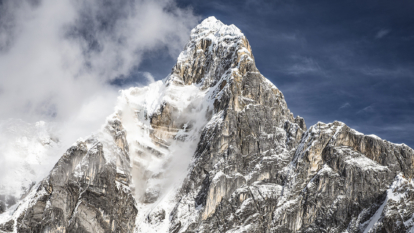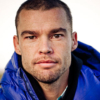Jirishanca
Hard alpinism in the Cordillera Huayhuash endures as the climate changes the routes.
All photos by Drew Smith
In July 2022, Vince Anderson and I climbed the unfinished Italian route, Suerte, to the summit of Jirishanca in Peru. Originally climbed to the ridge in 2003, the route has difficulties from 5.13a to M7 and WI6, with what Vince calls “lots of psychedelic snow-climbing.”
I first traveled to Jirishanca in 2015 as a new dad looking for challenging, technical climbing on a big mountain that didn’t require the time, expense or logistical hurdles of the Himalaya. Jirishanca had uniquely hard free climbing in every genre, low objective hazard and a relatively short and inexpensive approach from the States. Of course, the mountain didn’t care that I was smitten and put up quite the fight. After getting turned away by miserable conditions in 2015 and 2018, and getting agonizingly close in 2019, the conditions, weather and strength of the team finally coalesced last year.
Jirishanca was the last of the 20,000-foot (6,000-meter) peaks in the Cordillera Huayhuash to be climbed. An Austrian team, led by Toni Egger, completed the first ascent in 1957. (Yes, the same Toni Egger of the Cerro Torre controversy.) Given the climbing gear of the time, their ascent was extraordinary: Crampons were all nonrigid, strap-on models back then, and steep ice had to be climbed by chopping steps.
That said, after studying photographs taken during the Austrians’ first ascent over 60 years ago, it seems the upper portion of the mountain has transformed from a wide, low-angle snow ridge into a series of steep, complex ice roofs, snow mushrooms and rock steps.
This was the first climb I’ve done where it was painfully obvious that climate change has had a dramatic effect on the mountain. In the seven years that I made four trips to Jirishanca, we walked on less glacier to get to the base, found less ice through key passages and saw the dramatic upper ice roofs recede to reveal more and more chossy rock. This made the climbing harder in some places and easier in others, but it was always clear that things were changing very quickly. Given how close we came to the summit in 2019, and the fact that my travel to Peru was intimately linked with the mountain’s melting, I debated whether it was justifiable to return. In the end, the project proved too compelling to let go, but the experience has inspired changes. I’ve decided to travel less for climbing and look for inspiring objectives closer to home. I’ve also spent a considerable amount of time volunteering on a regenerative grazing farm. It’s not enough, but it’s something.
Watch the film about Josh and Vince’s ascent at Patagonia Stories.
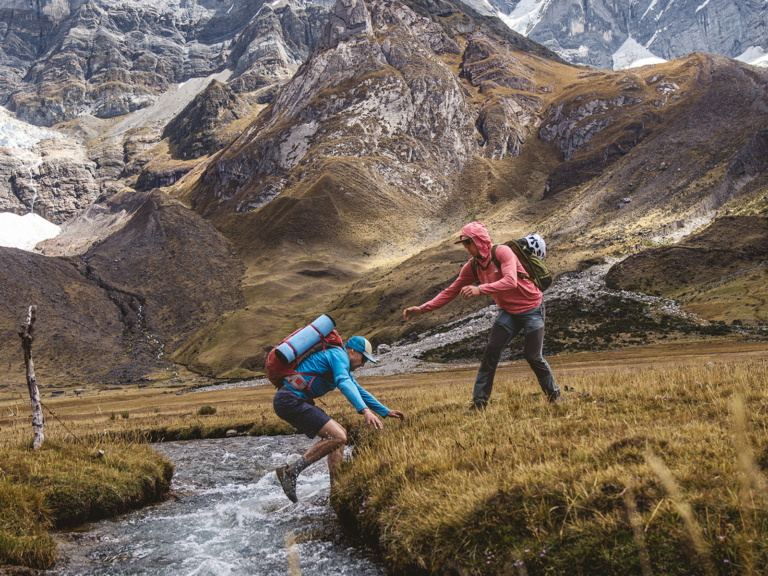
Vince is excellent at a number of things, particularly when it comes to toughing it out on the mountain, but it turns out he has a good broad jump, too. While the rest of us contemplated how to cross this creek on the approach, he knew exactly what to do: “Thrilled my 52-year-old legs still have it!” I, on the other hand, am three knee surgeries in and came up short.
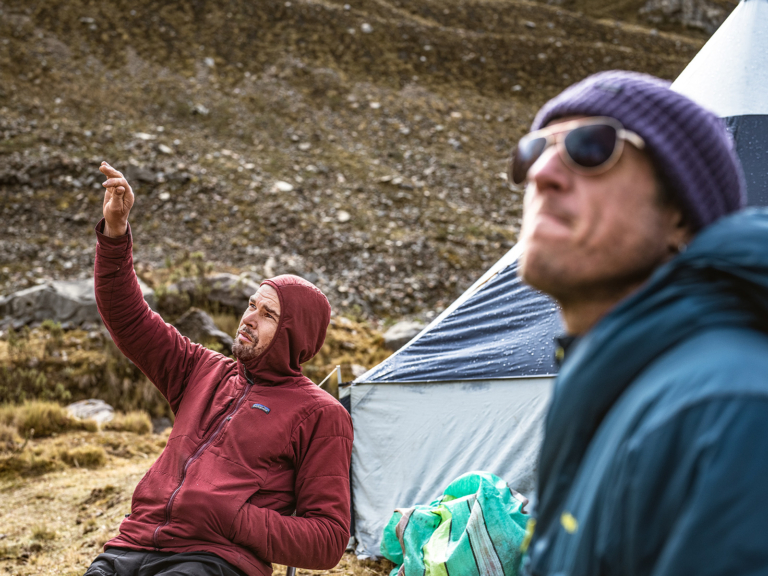
Vince (wearing sunglasses) and I spent lots of time determining the best path through the ice roofs and upper snow ridge, but it’s all speculative until you’re actually up there. However, last year we were able to examine the summit ridge in advance with a drone, something we’d never done before. The final stretch to the summit looked harder than I had imagined. Chris Alstrin, one of the team’s videographers, said, “Don’t worry, the drone adds 10 degrees.” Fortunately, he was right.
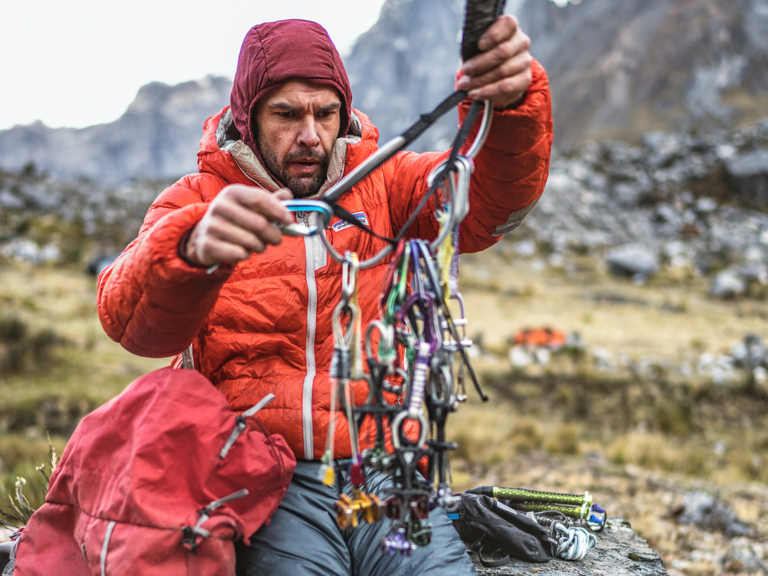
Here I am racking up. Packing is about whittling everything down to the absolute necessities and then sneaking in a creature comfort or two for morale. A tiny toothbrush or square of chocolate feels like a treat at an uncomfortable bivy or belay. Years of collective experience made packing relatively simple for me and Vince, but finding balance between lightweight and suffering is always tricky.
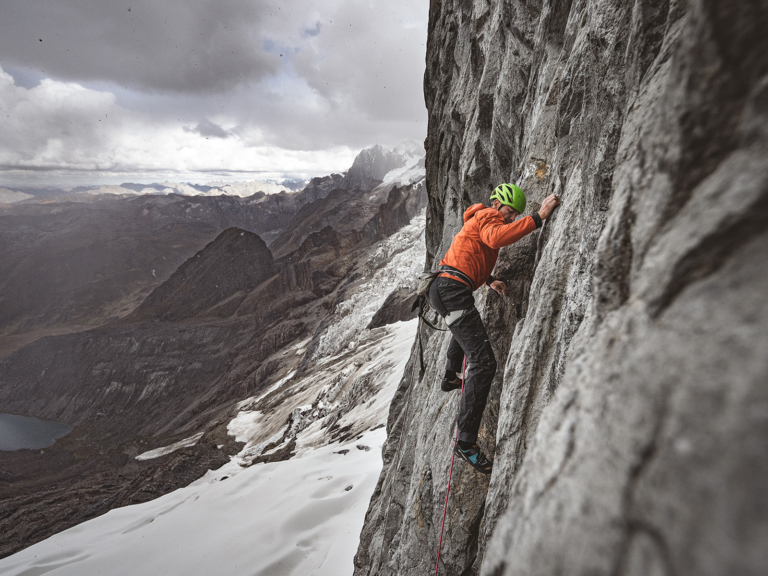
Pitch 3 of 39, just as a storm began to spit. This lower section of the mountain is relatively safe to free climb because of bolts placed in 2003 by the Italian team of Stefano DeLuca, Paolo Stoppini and Alessandro Piccini. While bolting in the alpine raises some interesting ethical issues, there’s no doubt that it’s enabled some great climbing here. “The rock climbing on the lower portion of the wall was exceptional and would easily be a sought-after classic in its own right if it were in a more accessible place in the world,” Vince says. “It’s bullet-hard, crisp limestone with thought-provoking technical movement on many pitches.”
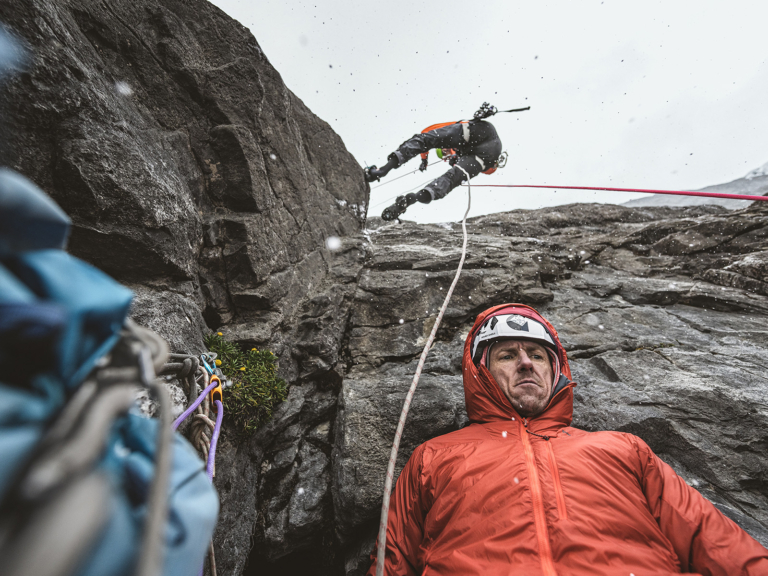
Rappelling back down to Vince after climbing Pitch 3. “That’s my serious face,” Vince says. “A lot of people have told me that I have a very serious face, but I never believed them until I saw this. One of my sons recently told me he read that one in nine people have a ‘serious face.’ I guess I’m lucky!”
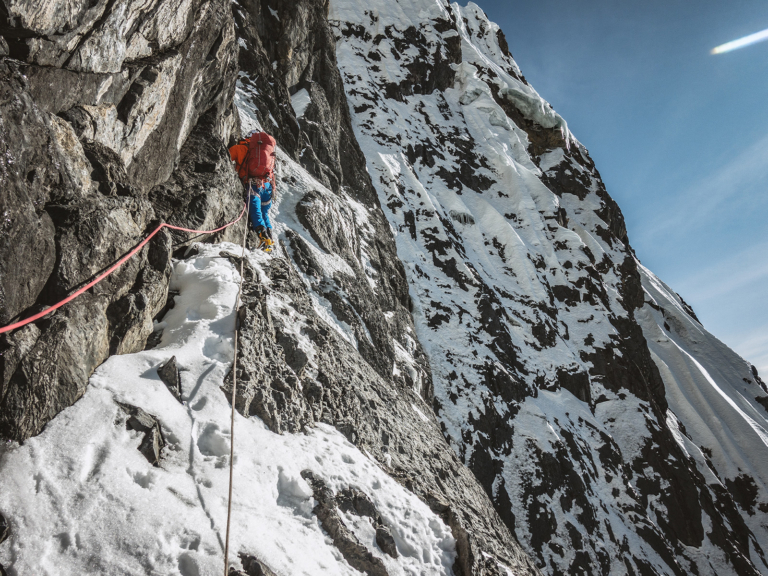
Vince leads across an easy traverse in the bottom third of the southeast face. This traverse deposits you into a steep ice gully, which is objectively the most dangerous part of the mountain. When the sun hits the wall above, it releases rocks into this gully, and on this morning, I was hit by a softball-sized rock in the shoulder. Fortunately, this is the only part of the mountain with significant objective hazard. Photo: Josh Wharton
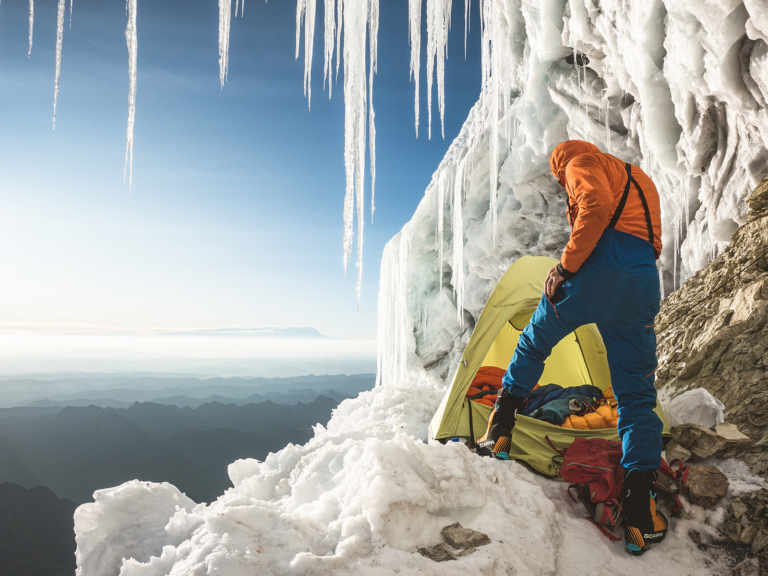
Although this perch looks dramatic with the hanging daggers and a huge swell of ice overhead, this bivouac under the first ice roof is actually welcome horizontal terrain. With a little chopping, we were able to have a comfortable night’s sleep and were safely protected from any debris falling from above. These roofs exist due to the receding ice, which exposes loose rock that’s been buried under the glacier for millennia. Based on how much they’ve retreated in the years between our attempts, Vince imagines that even these “eyebrows” of ice might disappear in a few decades. I suspect Jirishanca may become solely a rock climb in my lifetime. Photo: Josh Wharton
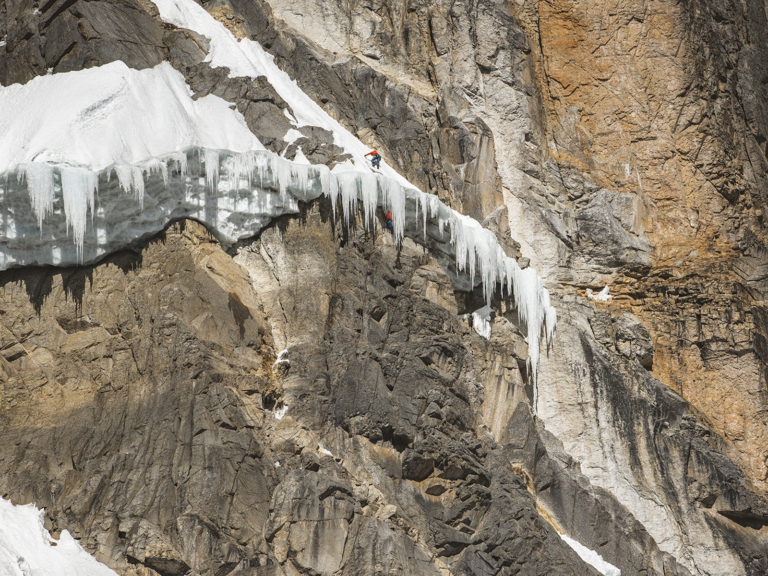
Climate change is melting the ice and snow on Peru’s mountains very quickly. In only seven years, the easiest path up the mountain has evolved significantly. On my first attempt in 2015, we easily circumvented the first ice roof you see here via a huge ice pillar, and at the second ice roof, we aid-climbed out on ice screws. On our successful climb in 2022, we were forced to climb the first ice roof via 16 feet (5 meters) of chossy rock climbing, and the second via two rock pitches before this short, steep ice roof. It’s very unlikely [Toni] Egger and [Siegfried] Jungmair could have climbed such technical ice roofs with the gear they had in 1957, but from studying historical photos, it appears that these roofs didn’t exist on the route in the 1950s and instead were once part of a solid glaciated sheet.
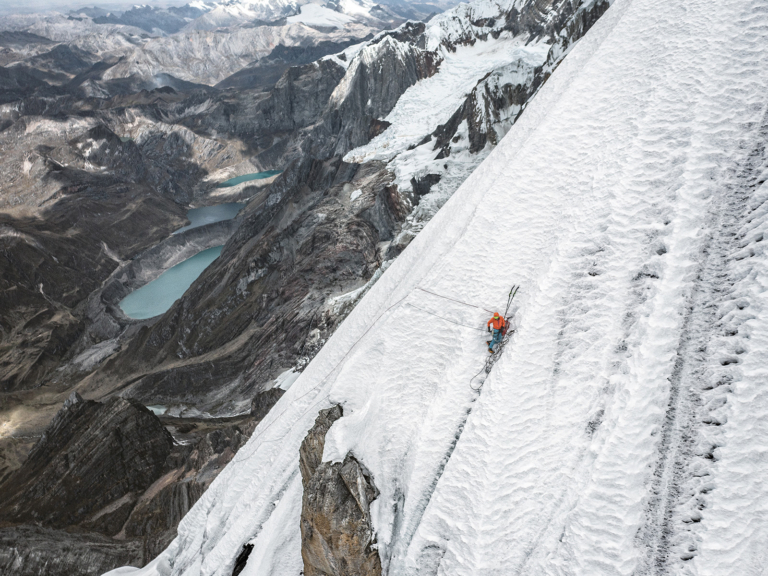
The snow conditions on the upper ridge were excellent. On my first trip to Jirishanca in 2015, we turned around approximately 300 feet (100 meters) below where this photo of me was taken, stuck in unconsolidated, chest-deep snow. This time, I waited for the inevitable sugar-snow horror show that Peru’s mountains are infamous for, but it never came. Yet, even though this area was relatively easy to ascend, it was hard to navigate on the way down. “It was up and over, up and over, with a lot of slight traverses right,” Vince remembers. “In the dark and our post-summit fatigue, we had a hard time retracing our steps and nearly went down the wrong side of a few ice roofs and rock buttresses.”
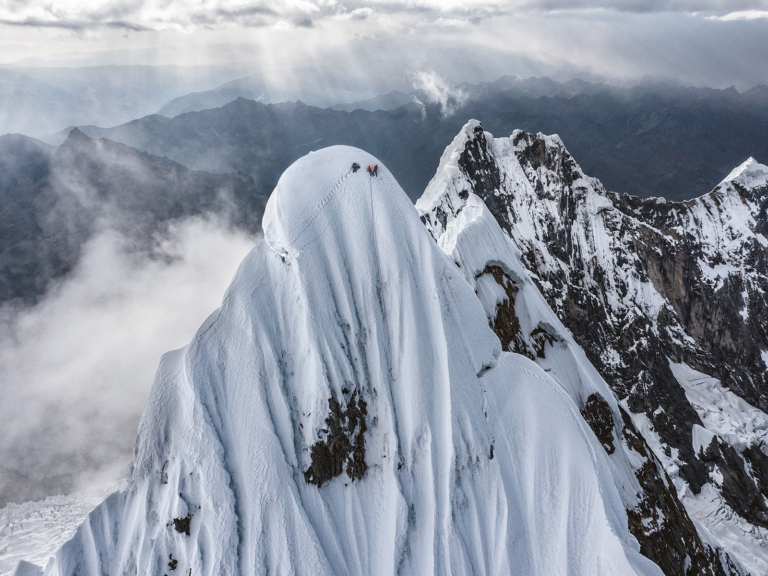
By chance, Canadian climbers Alik Berg and Quentin Roberts were also on Jirishanca, attempting a new route on the east side. Vince and I spent time with them at base camp, but we hadn’t coordinated our climbing efforts, so you can imagine my surprise when Alik popped up over the ridge a few minutes after me! Jirishanca hadn’t been summited in 20 years. It would have been an amazing coincidence if they had arrived within an hour of us; for both teams to summit within five minutes of each other felt truly wild. We greeted each other with big smiles, happy and relieved that they would be able to follow our tracks and rappel anchors down the mountain.
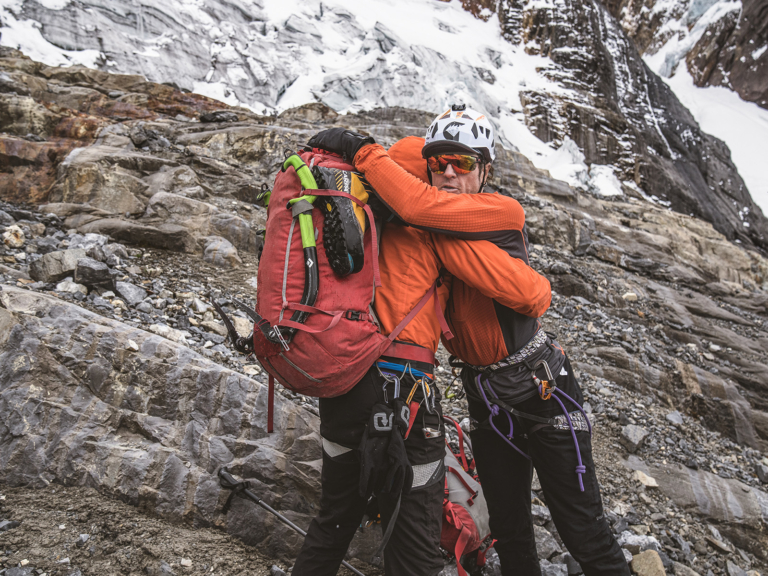
One of the things I love most about alpinism is the bonds it creates. From traveling together to time spent at base camp and the climbing itself, it fosters deep friendships and relationships not easily found in other parts of life. Alpinism is unique from other genres of climbing: It’s a true team sport where you’re only as good as the sum of your parts.
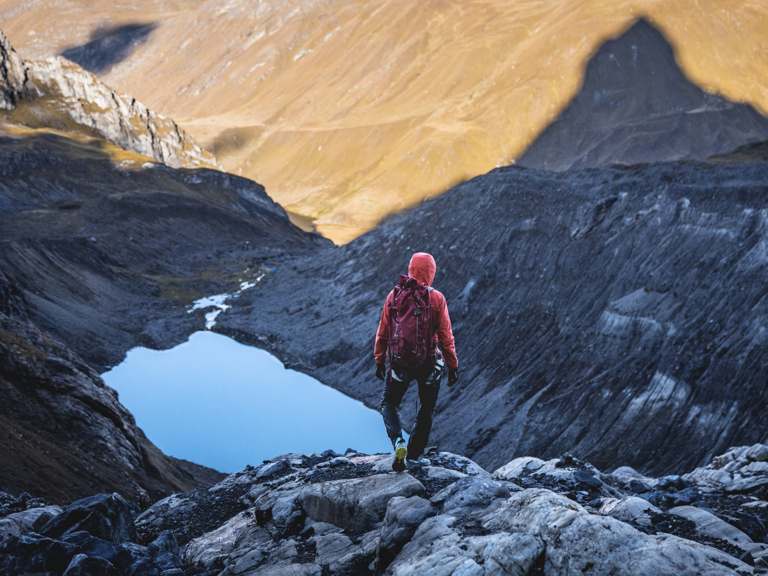
Each previous time I’d walked away from Jirishanca, my mind had churned with the details of what it would take to see it through to the summit. In this moment, I walked with deep satisfaction and gratitude, my mind finally at ease. Vince says it nicely: “After narrowing my focus on the minutiae and intimacies of the climb itself, I love it when I can finally, more fully see the light and beauty of the other parts of the mountain—the shadows and the valleys below.”
When we left the summit, the descent felt endless: route-finding mishaps, tangled ropes, a tired trudge out from base camp, buses, more buses, planes and driving—it sort of felt like we rappelled for six days straight. The descent really only felt finished when I pulled into my driveway and gave my wife and daughter a giant hug.
Josh Wharton lives in Estes Park, Colorado, with his family and six chickens led by a Machiavellian leghorn named Thor the Destroyer.
Vince Anderson lives in Grand Junction, Colorado, splitting his time as a “trad dad” of three boys and running his guide service, Skyward Mountaineering.
Drew Smith lives everywhere and nowhere, camera in hand, dirty
and happy.
Watch the film Jirishanca about Josh and Vince’s ascent:
